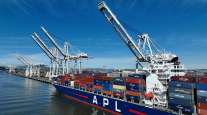Los Angeles Delays Hit Sales as No. 1 US Port Suffers

After years of ending the holiday shopping season with too much merchandise stacked in their warehouses, U.S. retailers face the opposite this year: They may not have enough.
Equipment shortages, labor negotiations and rail delays are slowing shipments from the Ports of Los Angeles and Long Beach, the nation’s biggest container hub, just as retailers are piling up goods for their most important period of the year. Cargo shipments through the two ports rose 3.1% in the third quarter, slower than the 4.3% gain a year earlier.
The turmoil comes at a bad time for merchants — scarred by the weak sales that followed the financial crisis — that have been keeping inventories lean to avoid resorting to profit-eating discounts to clear out the unsold goods. Retailers in the Standard & Poor’s 500 Index grew inventories at 86% of the rate they boosted sales in the most recent quarter, according to data compiled by Bloomberg News. A year earlier, inventories expanded 1.72 times as fast as sales.
“They’ve essentially squeezed out the buffer time to react if there’s an issue,” said Frank Layo, a partner at retail-consulting firm Kurt Salmon in Atlanta. “As soon as you introduce some serious supply-chain risk, you’ve painted yourself into a corner.”
That cushion would have been useful this year. Storage space at several of the Port of Los Angeles’ container terminals are 90% full as shipments wait to be trucked to customers, Phillip Sanfield, a spokesman for the harbor, said by telephone. A large part of the problem is the scarcity of chassis, the wheeled metal frames that carry containers behind trucks, he said.
Shipping lines have been exiting the costly business of maintaining and operating chassis in the last year and a half, and the operators that have taken over are still getting the hang of supplying enough chassis at the right time and place, Sanfield said.
“Some of the logistics have caused a shortage of chassis in the pool, at times a significant shortage where they’re needed,” he said. “Last year, it was beginning to be an issue. This year, combined with the peak season, it’s obviously legitimate to say we have a significant issue.”
Labor negotiations have worsened the problem, Sanfield said. The ports have been working with chassis operators to form a pool that would help them better coordinate where the equipment is needed, Sanfield said. Such a network may require the approval of the International Longshore and Warehouse Union. That group’s leaders have been mired in negotiations with U.S. West Coast terminal operators since their contract expired in June.
A tentative deal between the longshoreman and the Pacific Maritime Association, representing management, may be reached within weeks, Gene Seroka, executive director of the Port of Los Angeles, said Oct. 23. Both sides “have a mutual respect,” he said at a business luncheon in Los Angeles.
The situation is coming at an inopportune time for retailers. Purchases in November and December are projected to account for 19% of U.S. retailers’ annual sales, according to the National Retail Federation. Holiday sales this year may advance 4.1% to $617 billion in those two months, topping last year’s 3.1% gain and the 10-year average of 2.9%, the trade group said.
Most Christmas merchandise already is on store shelves, though a work stoppage at the ports could become an issue if retailers need to replenish supplies for last-minute shoppers, said Craig Johnson, president of Consumer Growth Partners.
“It isn’t going to affect the bulk of Christmas for the retailer,” he said. “Retailers looking to replenish hot products part way through the season could be impacted.”
While most big retail companies have a “diversified inbound strategy,” for shipments, a strike at the Los Angeles and Long Beach ports in the next few weeks would strand merchandise that’s currently at sea, Layo said.
“It’s not like you can just call up the captain of the ship and say, ‘Take a left and head up to Seattle,’” Layo said. “If it’s already left Shanghai, it’s at risk because you can’t just divert it easily.”
After hearing concerns from about the port situation, Layo convened a meeting with 10 major U.S. retailers to discuss the issue in Chicago earlier this month. He said most of the companies had reported delays moving cargo through Los Angeles to their stores across the country.
Target Corp., Costco Wholesale Corp., Home Depot Inc., Samsung Electronics Co. and Sears Holdings Inc.’s Kmart chain were the top five importers, by weight, at the Los Angeles and Long Beach ports through Oct. 14 this year, according to data compiled by Panjiva, a global trade research firm in New York. The ports handled about 149 billion kilograms (328 billion pounds) of goods last year.
Home Depot, which imported more than 163.7 million kilograms of goods through the two ports through Oct. 14, has “contingency plans in place for any disruptions, and that’s regardless of the reason those might occur,” Stephen Holmes, a spokesman, said in an e-mail.
“We construct our plans to allow for flexibility,” he said, adding that the company gets shipments through the other major U.S. ports at Seattle, New York and Savannah, Georgia.
Representatives of Costco, Target and Samsung declined to comment. Chris Brathwaite, a spokesman for Sears, declined to comment beyond saying the company is monitoring the situation daily.
Department stores and retailers with a healthy stock of products could probably ride out a work stoppage or rely on cargo coming in through other ports, Layo said. Fashion brands with seasonal products or retailers with strong demand for hot items may not have it so easy, he said.
“There’s a bad timing element to this, where if it breaks down over the next couple of weeks it’s going to put retailers at risk,” Layo said.




